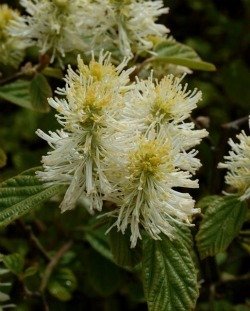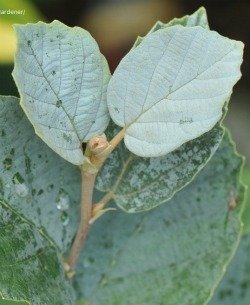





With gorgeous fall color, Fothergilla (witch-alder) should be more well known to gardeners. This native shrub deserves the spotlight for its fall foliage show. Spring flowers, ease of care, and versatility round out a profile of an excellent candidate for many landscapes. (Did I mention the gorgeous fall color?)
Fothergilla, or witch-alder, earns it keep in the landscape with more than fall color. In spring fothergilla sends out its flowers. White, puffy balls of flower stamens, like round brushes, sprout from all the branch tips. The blossoms are said to have a lovely, sweet scent. Leaves emerge with the flowers, and are small to medium sized, slightly toothed, and rounded oval. Summer leaf color tends to the dark green, some with a blue tone. Several cultivars are bred to enhance the blue summer tones. Then, blue or not, fothergilla blazes with an extraordinary autumn show. All fothergilla have brilliant fall color; many bear bright yellows, oranges, and reds together on the same bush. After the autumn display, the bush sheds its leaves and takes a well deserved rest.
 Left: Fothergilla 'Mt Airy' bloom picture by growin titled "UBC Botanical Garden"
Left: Fothergilla 'Mt Airy' bloom picture by growin titled "UBC Botanical Garden"Native witch-alders are found growing in moist woodland or nearly swampy sites, with acid, humusy (organic rich), soil. The names dwarf fothergilla and large fothergilla are commonly used to differentiate the smaller from the larger growing species. Dr. John Fothergill appreciated American witch-alders in the 1700s, planted them in England, and donated his name to the genus. Fothergilla has a mostly upright form, with suckering stems making a compact rounded bush. Plant professionals have now developed several cultivars of fothergilla. They've found that these bushes grow well in the landscape or naturalized on a woodsy property. Fothergilla is a slow but steady grower, making pruning easy. (And that autumn foliage display knocks me out.)
Experts say that fothergilla is remarkably pest and problem free. They've learned that it grows well in a range of situations, not just the moist, acidic soil of its native sites. Gardeners heartily agree on all counts. They give rave reviews of Fothergilla, from Washington state to Missouri to Delaware. Mature size of fothergilla is homeowner friendly. Smaller witch-alders (dwarf fothergilla) grow to two or three feet and the largest cultivars mature at, or are easily maintained at, six to eight feet tall. Several sources advise that fothergilla can take some shade but have a better bloom and richer fall color when given more sun. Various selections are noted as hardy in zones 4 to 9. (Look up at that first picture again; tell me, is that not beautiful?)
The wild species of fothergilla have been used to produce several cultivars. Here's where some variation comes into play. Shop for "fothergilla" or "dwarf fothergilla" according to cultivar name. Select the mature size and form that suits your foundation planting scheme, shrub border, or natural garden. All fothergilla have white blooms. Choose from the following according to your preferences:
Cultivars (named plants bred for specific traits)
'Mt Airy' was selected by Michael Dirr. He found it better than the species Fothergilla major in all characteristics. Outstanding fall color and improved flowering are just two of its strengths. 'Mt. Airy' is a medium sized witch-alder, maturing at 3 to 5 feet in height, according to various sources.This may be the most popular of the cultivars.
'Blue Mist' was chosen for cool bluish summer foliage on a smaller bush. Its parent is the native dwarf fothergilla. 'Blue Mist' also has the characteristic, full range autumn colors. It grows to just two or three feet tall. 'Blue Mist' is the widely available choice for a shorter shrub. University of Connecticutt says its fall color is not as consistently excellent as some other witch-alders, and may not be as cold hardy either.

'Blue Shadow' The leaves on this selection have a distinctive waxy coating giving them a silvery blue color in summer. Autumn brings out a spectacular show of the species' range of yellow, orange, and red. 'Blue Shadow' was selected from a project propagating 'Mt Airy', and combines the superior attributes of 'Mt Airy' with a unique blue summer foliage. This selection grows to about five feet tall and wide.
'Klmtwo' BEAVER CREEK is a dwarf fothergilla, growing to just 2 or 3 feet tall. Summer leaves are somewhat bluegreen and fall color tends more to reds.
'Jane Platt' is a low growing (2 feet), spreading selection. It has slightly larger flowers, is light green in summer, and gives a respectable (but not the most outstanding) display in fall
'Klmsixteen' MAY BOUQUETis the largest in mature size of these cultivars, and bears the biggest roundest flowers, too. It will grow to 6 or 8 feet, though slowly like all fothergillas.
'Arkansas Beauty' This is a large Fothergilla, growing to about six feet. Summer leaf color is a light green, fall color shows the whole, spectacular, red to yellow range. It often blooms before leaves emerge.
'Red Licorice' Here's a large fothergilla with a mostly cherry red autumn color, according to Rare Finds Nursery. It grows to about seven feet tall.
Species (If only the genus and species are listed, the plant in question should be assumed to be an unselected native bush.)
Fothergilla gardenii Dwarf fothergilla This species is small in stature, only growing to two or three feet. Kathleen Fisher, in Taylor's Guide Shrubs says it is a bit more tolerant of dry soil than the F. major. Gardenii suckers more than major. The species is named for Dr. Alexander Garden South Carolina botanist whose name also graces the gardenia.'Blue Mist', 'Klmtwo' BEAVER CREEK, and 'Jane Platt' are cultivars of this species.
Fothergilla major This species is the full-sized witch-alder. It is "major", meaning bigger than the dwarf, in both overall size and the size of its flowers. It can eventually, though slowly, grow to about eight feet tall (ocassionally to more than ten) and nearly as wide. This species is found in woodlands of the coastal Southeast. F. major is native mostly in Georgia, and found occasionally in several states around that area. Select this only if the largest size fothergilla is your aim. Cultivar 'Mt Airy' is considered an improvement in overall quality, but doesn't grow as large.
Fothergilla monticola Very similar to F, major , and possibly the same species. 'Klmsixteen' MAY BOUQUET may be listed as an F. monticola. This group describes a large shrub, more waxy-leafed than F. major, and slightly more spreading with its stems and suckers, according to William Cullina of the New England Wildflower Society.
~~∞~~ ~~∞~~ ~~∞~~
Fothergilla appears as the "poster child" on this informative page about low growing deciduous shrubs from the Morton Arboretum
Fothergilla (species) Missouri Botanical Gardens accessed 10-17-2011
Plant database University of Connecticut accessed 10-18-2011
Dwarf Fothergilla. Ohio State University accessed 10-18-2011
Fothergilla major, Plant Profile, Floridata accessed 10-16-2011
Cullina, Milliam. Native Trees, Shrubs, and Vines. Boston, Houghton Mifflin Co., 2002.
Dirr, Michael A. Hardy Trees and Shrubs: An Illustrated Encyclopedia Timber Press, 1997.
Fisher, Kathleen. Shrubs (Taylor's Guides) Boston, Houghton Mifflin Co, 2000.
Various PlantScout participating vendors
Natural Landcapes Nursery
RareFind Nursery lists eight kinds of fothergilla, a veritable cornucopia of this genus.
Beaver Creek Nursery
Edge of the Woods Native Plant Nursery
(Editor's Note: This article was originally published on October 25, 2011. Your comments are welcome, but please be aware that authors of previously published articles may not be able to promptly respond to new questions or comments.)
Copyright © www.100flowers.win Botanic Garden All Rights Reserved